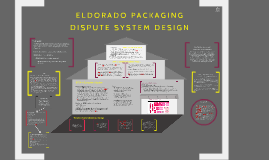DSD
Transcript: How do they TRUST the system? Employees will have greater trust in the system and will better overcome their reluctance to complain because the system emphasises the employee’s control over the process. The employee is given the choice whether to remain anonymous and the complaint is kept confidential. Depending on the action they select, the survey will warn the employee whether that action requires that the employee is identified. The employee then has the choice whether to pursue the complaint, which gives them the control over the process. The system gains credibility from being monitored by an independent advisor so employees feel more comfortable complaining to someone external to the company. How do people ENTER the system? – referral, voluntary 1. Paper form 2. Online portal or email 3. App on devices We propose a complaints survey in the form of an online portal, app and paper survey to cover everyone’s needs. The surveys will be monitored/screened by an independent company and advisor. Process The survey will give the employee all the information necessary to inform them of the options they can take to deal with their harassment complaint. The survey will first list the type of complaints that the employee might be facing. It will then list their options and potential actions they can take. The employee can choose from a range of actions as Burgess and Burgess propose a cyclical model of conflict resolution with multiple options is more effective than linear one that focuses only on resolution. AH Maslow, “A Theory of Human Motivation” (1943) 50(4) Psychological Review 370. Bush R and Folger J, The Promise of Mediation: Responding to Conflict Through Empowerment and Recognition Jossey-Bass (Jossey-Bass, San Francisco, 1994) p 84. C Constantino and C Sickles Merchant, Designing Conflict Management Systems (Jossey-Bass, San Francisco, 1996) p 200. G Burgess and H burgess Constructive Confrontation Theoretical Framework (1996) p1-11, available on http://www.colorado.edu.au/conflict/hwltap7.com. Susan Hippensteele, Revisiting the promise of mediation for employment discrimination claims (2009) Pepperdine Dispute Resolution Law Journal 9, no. 2, p 211-250. J David and Associates, Designing a Dispute Resolution System, Keynote Paper (Second international Mediation Conference, Adelaide, January 1996). Lisa Blomgren Amsler et al, ‘Dispute System Design and Bias in Dispute Resolution’ (2017) 70 SMU Law Review 913. L Kriesberg, Constructive Conflicts: From Escalation to Resolution (2nd Ed, Rowman and Littlefield, New York, 2003). Mark Dickinson, ‘The importance of transformative mediation to the internal workplace mediation program’ (2011) 22 ADRJ 95 Mediate.com, Guidelines For the Design of Integrated Conflict Management Systems Within Organisations-Executive Summary, available on https://www.mediate.com/articles/spidrtrack1.cfm. S Retzinger and T Scheff, “Emotion, Alienation and Narratives: Resolving Intractable Conflict” (2000) Mediation Quarterly 71, 76. Standards Australia, AS4608-1999: Guide to the Prevention, Handling and Resolution of Disputes (1999); Standards Australia, AS4608-2004: Dispute Management Systems (2004). What current processes are in place? It is assumed that Eldorado Packaging does not currently have a dispute system design, and if they do it is not currently being effective. Who are the stakeholders/participants? Employees, past present and future Employer - Eldorado Packaging Workplace Harmony Commission Fair Work Australia Customers What are their interests? New employees may have a fear of harassment from the long-term employees and a fear of repercussions if they complain. Long-term employees may feel threatened by new employees and fear for their job security or harass others because it is part of the company culture. The employer has a financial incentive to improve the retention of their employees. It reduces constant hiring and training costs and they will receive a bonus if they retain more staff. WHC is interested in reducing harassment in Eldorado and turning it into a more productive community. Fair Work Australia is interested in resolving workplace disputes and bullying complaints. Customers are impacted by the efficiency and cost effectiveness of the company. Workplace harmony and higher productivity will have a flow on effect to the customer. What are the stakeholders/participants’ goals? Achieving staff retention of at least 70% per annum E L D O R A D O P A C K A G I N G From this brief, the key principles can be distilled into stages: STAGE 1: Design complaint system STAGE 2: Identify and resolve harassment STAGE 3: Achieve a long term cultural change in the workplace DIAGNOSTIC PROCESS Understanding the current situation and the needs of Eldorado Packaging will inform the design in the initial stages. These are also important to test the workability of the potential system design. The diagnostic process we have used included assessing the following areas... By:

















